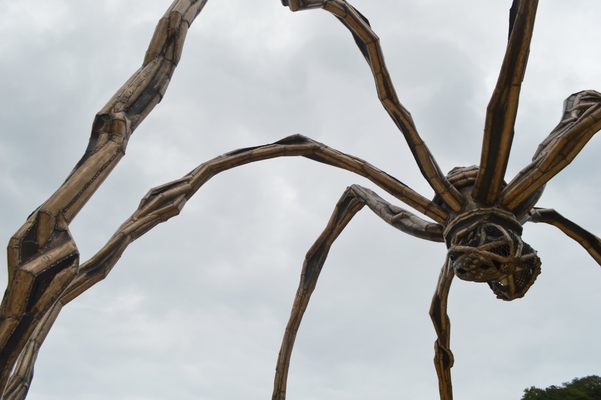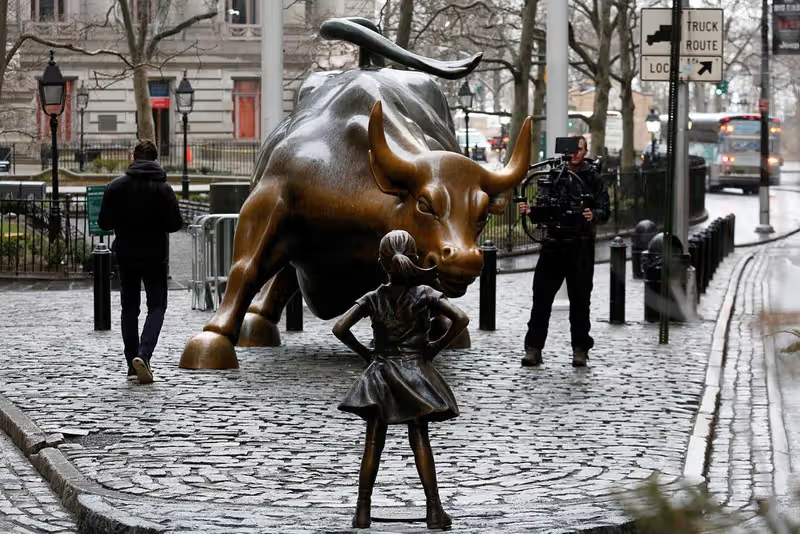Top 10 Most Famous Public Art Ever & Why They Matter
- calypso186
- Mar 25
- 16 min read
Discover the public art that changed history. From community-based art to monumental land art installations, Artelier's public art management unpacks their significance through time.

Click on a question to expand it for the answer.
Why is public art important?
4 Benefits of public art
How does art in public shape communities & cultures?
FAMOUS PUBLIC ART
& WHY
The Thinker, 1904 — Paris

Rodin’s The Thinker is one of the most famous and widely recognised public art sculptures ever created, celebrated for its uniquely contemplative pose and hyper-realistic detail. The bronze figure has been cast at least 28 times, with the original towering over visitors at the Rodin Museum in Paris, which attracts 600,000 visitors annually.
Originally titled The Poet, the sculpture was conceived as part of The Gates of Hell (1880–1917) — Rodin’s grand, highly intricate masterpiece inspired by Dante’s Inferno. The figure initially represented Dante himself, gazing down at the tormented souls of the underworld. However, when the bronze was first displayed in public in 1888, it was so revered that it became an independent artwork, transcending its initial purpose.
Why was Rodin's The Thinker so famous at the time?
What can we learn from Rodin's The Thinker today?
La Grande Vitesse, 1969 — Michigan

Alexander Calder’s La Grande Vitesse (known by locals as The Calder) is an iconic example of modern public art. It was the first public art installation funded by the National Endowment for the Arts' Art in Public Places program, and the most controversial. Sanding 54 feet long, 43 feet high, and 30 feet wide, it was designed to offer dramatically different views from each corner of the square.
The sculpture marked a bold experiment in integrating public art within an everyday urban environment. With its striking red steel forms, it was deliberately placed in a public plaza, now Calder Plaza, to embed art within the city’s social fabric. Its dynamic, curvilinear forms exemplify Calder’s signature stabile sculptures, which appear to defy gravity while remaining firmly grounded.
What made Calder's La Grande Vitesse so controversial?
How did the government respond to the controversy around La Grande Vitesse?
Spiral Jetty, 1970 — Great Salt Lake, Utah

One of the most famous examples of Land Art, Spiral Jetty by Robert Smithson is a monumental earthwork that extends into the Great Salt Lake, Utah. Constructed using over 6,000 tons of basalt rock, soil, and salt crystals, the 1,500-foot-long coil emerges and disappears with the lake’s fluctuating water levels, making it one of the few public artworks that are naturally ephemeral.
Smithson’s vision was radical: instead of confining art to a gallery, he sought to integrate public art into the natural environment, challenging conventional notions of permanence and ownership, and counteracting commercial gallery incentives. “I think that’s more or less run its course – the typical idea of exhibitions in a museum.” — Robert Smithson, 1971. Its spiral form symbolises cycles of life, death and rebirth, mirroring the expansion and contraction of the universe. More than a striking public art sculpture, its ever-changing state challenges traditional preservation, making it a key case study for a unique public art strategy. With over 700 daily visitors, Spiral Jetty highlights the impact of public art on communities, fostering reflection on the relationship between art, time and the environment.
How does Spiral Jetty challenge traditional public art?
Why is Spiral Jetty still relevant today?
The Vietnam Veterans Memorial, 1982 — Washington

The monumental Vietnam Veterans Memorial is one of the most influential public art sculptures of the modern era, redefining how we engage with memorial art in urban spaces. Completed in 1982, this groundbreaking work consists of a black granite wall inscribed with over 58,000 names, honouring those who served in the Vietnam War. Unlike traditional war monuments, its minimalist design fosters quiet introspection, with the highly reflective surface allowing visitors to see themselves alongside the fallen.
Beyond commemoration, Lin’s memorial is a strategic model for public art in urban planning. By beginning the artist-selection process with a competition, this allowed for a democractic process. prioritising a simplistic reflective design over grandeur, it demonstrates that public art sculptures, especially memorials, have to be deeply considered in their approach given that the subject matter is so sensitive. As public art consultants, we see this as a vital precedent: a reminder that successful public art strategy isn’t just about visibility but about designing spaces that explore innovative ways to address the specific goal of the public art brief, fostering a deeper sense of place.
What was the controversy over the Maya Lin Vietnam Memorial?
Why does the Maya Lin controversy matter?
Angel of the North, 1999 — London

Towering at 20 metres tall with a 54-metre wingspan, the colossal steel figure stands watch over the A1 motorway, seen by 33 million passersby annually. Inspired by the region’s industrial heritage, the angel pays homage to the miners who once worked beneath the very land it stands on.
What makes the Angel of the North such an iconic piece of public art is its bold simplicity and commanding presence. Unlike traditional monuments, Gormley’s angel has no facial features — yet it exudes a sense of strength, protection, and human connection. Its rusted Corten steel surface evolves over time, blending with the landscape and reinforcing the idea that public art should interact with its surroundings rather than dominate them.
What is the meaning behind the Angel of the North?
Maman, 1999 — London, Tokyo & more

Louise Bourgeois’ Maman is one of the most famous and haunting public sculptures of the 20th century. Standing over 9 metres tall, the imposing bronze spider has been permanently installed in cities worldwide, from London and Ottawa to Tokyo and Bilbao. At once delicate and menacing, it reflects Bourgeois’ personal themes of motherhood, memory and protection.
Maman is so strong as a public artwork because it absolutely catches the viewer off guard. With 3-15% of the global population aracnophobic, and the rest largely pretty repelled to spiders, Louise Bourgeois' Maman is exceptionally confronting. It's long, spindly legs by portraying a spider — a creature often associated with fear — as a symbol of maternal strength. Its elongated, spindly legs create a contrast between fragility and power, making it a compelling public artwork that evokes deep emotional responses from viewers.
What is the meaning of Maman by Louise Bourgeois?
Why is Maman still relevant today?
Cloud Gate, 2006 — Chicago

Few public art installations have transformed an urban space as profoundly as Cloud Gate, affectionately nicknamed The Bean. Created by renowned British-Indian artist Anish Kapoor, this mirrored stainless-steel sculpture has become one of the most photographed landmarks in the world, drawing millions of visitors annually to Millennium Park, Chicago.
Inspired by the qualities of liquid mercury, Kapoor’s 110-tonne elliptical structure is designed to reflect and distort the surrounding skyline, creating an immersive and interactive experience. The sculpture is a masterclass in urban placemaking, turning a once-ordinary plaza into a cultural and social hub. By engaging with its reflective surface, visitors become part of the artwork, merging with the cityscape in a seamless dialogue between art, architecture, and public life.
Why is Cloud Gate one of the most successful public art pieces?
Why was Cloud Gate controversial?
Despite its immense popularity, Cloud Gate faced initial criticism, particularly over its cost—a staggering $23 million, significantly exceeding its original budget. Additionally, some questioned whether Kapoor’s avant-garde design was the right fit for Chicago’s urban landscape. Others criticised its corporate-friendly aesthetic, arguing that highly polished, non-disruptive art lacks the subversive power that defines impactful public works.
However, over time, the sculpture has become a beloved symbol of the city, proving that visionary public art can transcend early scepticism to become a defining cultural landmark.
The Kelpies, 2013 — Scotland

Standing majestically at the gateway to Scotland’s Forth and Clyde Canal, The Kelpies are among the most visually arresting public sculptures in Europe. Designed by Andy Scott and unveiled in 2013, these 30-metre-high horse-head sculptures pay tribute to the working horses that powered Scotland’s industrial growth. Drawing inspiration from Celtic mythology, the name “kelpie” references shape-shifting water spirits that often took the form of horses, merging industrial history with mythological intrigue.
As a public landmark, The Kelpies succeed by forging a powerful connection between place, heritage, and contemporary sculpture. Their towering scale transforms the landscape into a dynamic cultural site, attracting millions of visitors and contributing significantly to public art tourism in Scotland. For public art planners, The Kelpies illustrate the potential of public monuments to drive economic growth while preserving cultural narratives in modern contexts.
What is so special about The Kelpies as an art installation?
The Floating Piers, 2014-16 — Lake Iseo, Italy

Christo and Jeanne-Claude’s The Floating Piers was a breathtaking site-specific public art installation that allowed visitors to walk on water — literally. The vibrant golden walkways made from high density polyethylene anchored to the bottom of the lake, stretched for 3 kilometres across Lake Iseo, connecting the mainland to the small island of Monte Isola. Over 1.2 million visitors flocked to the installation within its short 16-day existence, drawn to its ephemeral beauty and surreal physical experience. The project, 40 years in the making, exemplified Christo’s dedication to transforming landscapes into immersive, interactive experiences.
What made The Floating Piers such a groundbreaking public artwork was its ability to blur the line between viewer and participant. Unlike static monuments, this work made the audience an integral part of the piece, shifting art from an object to an experience. It also demonstrated the power of temporary public art, proving that some of the most powerful artistic statements are fleeting—intensifying their impact and fostering collective memory.
What was the purpose of The Floating Piers?
How did The Floating Piers impact the local community?
Fearless Girl, 2017 — New York City

Kristen Visbal’s Fearless Girl emerged as a symbol of empowerment and resistance when it was installed opposite the Charging Bull in New York’s Financial District in 2017. Standing defiantly with hands on her hips, the bronze sculpture captures the spirit of resilience and determination, embodying the growing demand for gender equality in the corporate world. Commissioned by State Street Global Advisors to promote their gender diversity index fund, Fearless Girl sparked global conversations about representation and leadership in traditionally male-dominated spaces.
How was Fearless Girl received?
What can we learn from Fearless Girl today?
Contact our Public Art Strategy Firm

We hope you’ve enjoyed exploring these famous public art examples from around the world and how they continue to shape cities, culture and communities. Learning from iconic public art installations helps inform the future of meaningful and impactful public art commissions.
At Artelier, we specialise in curating and strategising bespoke public art projects that enhance urban spaces, corporate environments, and cultural landmarks. With a team of 12 dedicated consultants, our expertise spans public art masterplanning, artist commissioning, and curation, ensuring that each project is both visionary and contextually relevant.
If you’re considering a public art strategy, we offer a fully turnkey public art service — from research and concept development to execution. Get in touch with us to explore how we can bring your vision to life.
Further Reading

To take a deeper dive into the world of public art strategy, explore articles written by our public art strategy firm below:
This guide walks you through the full process of commissioning public art, from the initial idea to completion, covering key steps like contracts, budgets, and site selection. You'll also learn how to choose the right artists and materials, with industry tips on sustainability and technology by our expert public art agency.
This guide explains the fundamentals of Section 106 and how public art can enhance community well-being while preserving local character. In just five minutes, you'll understand everything you need to know about how developers meet Section 106 requirements through thoughtful public art.
This guide explores the vital role of public art consultants in urban development, detailing how they help developers, planners, and architects integrate meaningful public art into projects.

Curator, Art Researcher & Editor
Calypso is a passionate art-writer with extensive experience in artist liaison, public art strategy and project management. She has written for Artelier and international galleries combining deep art market research with solid art historical foundations.



































